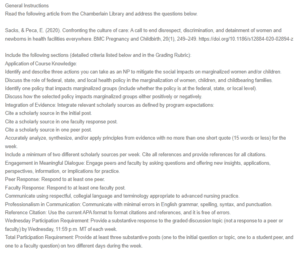Discussion – Mitigating Marginalization of Women and Children
Three Actions I Can Take as an NP to Mitigate the Social Impacts on Marginalized Women and/or Children
As a Nurse Practitioner (NP), there are several actions I can take. First, I can advocate for equitable and respectful care. This will ensure that all women and newborns are treated with dignity and respect in healthcare settings. Second, I can engage in cultural competence training. This will help me understand and address the diverse needs of marginalized populations. Finally, I can actively participate in initiatives that aim to eliminate discrimination and bias in healthcare, which will promote inclusivity and improved outcomes for vulnerable women and children.
The Role of Federal, State, and Local Health Policy in the Marginalization of Women, Children, and Childbearing Families
Federal, state, and local health policies play a critical role. They can either exacerbate or alleviate the marginalization of women, children, and childbearing families. Inadequate funding, restrictive regulations, and disparities in healthcare access within these policies can disproportionately affect marginalized populations (Smith et al., 2022). Policies that fail to address social determinants of health can further contribute to disparities in maternal and child health outcomes. This perpetuates the cycle of marginalization for vulnerable individuals and families.
One Policy that Impacts Marginalized Groups
One policy that impacts marginalized groups at the state level in Florida is the state’s Medicaid expansion policy. Florida has not expanded Medicaid under the Affordable Care Act (ACA). This has left many low-income individuals and families without access to affordable healthcare. This policy disproportionately affects marginalized groups (Eliason et al., 2022) limiting their ability to obtain essential medical services. Furthermore, it increases healthcare disparities. Medicaid expansion at the state level could help improve healthcare access and reduce the social impacts on these vulnerable populations.
Impacts of the Selected Policy on Marginalized Groups
Expanding Medicaid would positively impact marginalized groups by improving healthcare access. It will address health disparities and provide a safety net for those who need it most. However, the lack of Medicaid expansion in Florida negatively impacts these groups. Many low-income individuals in these groups face significant barriers to accessing affordable healthcare (Aggarwal et al., 2022). This can result in delayed or inadequate medical care, poorer health outcomes, and increased financial strain. Additionally, it perpetuates their marginalized status.
References
Aggarwal, R., Gondi, S., & Wadhera, R. K. (2022). Comparison of Medicare Advantage vs traditional Medicare for health care access, affordability, and use of preventive services among adults with low income. JAMA Network Open, 5(6), e2215227-e2215227. https://doi.org/10.1001/jamanetworkopen.2022.15227
Eliason, E. L., Daw, J. R., & Allen, H. L. (2022). Association of Affordable Care Act Medicaid expansions with births among low-income women of reproductive age. Journal of Women’s Health, 31(7), 949-956. https://doi.org/10.1089/jwh.2021.0451
Smith, G. S., Anjum, E., Francis, C., Deanes, L., & Acey, C. (2022). Climate change, environmental disasters, and health inequities: the underlying role of structural inequalities. Current environmental health reports, 9(1), 80-89. https://doi.org/10.1007/s40572-022-00336-w
ORDER A PLAGIARISM-FREE PAPER HERE
We’ll write everything from scratch
Question

Mitigating Marginalization of Women and Children
General Instructions
Read the following article from the Chamberlain Library and address the questions below.
Sacks, & Peca, E. (2020). Confronting the culture of care: A call to end disrespect, discrimination, and detainment of women and newborns in health facilities everywhere. BMC Pregnancy and Childbirth, 20(1), 249–249. https://doi.org/10.1186/s12884-020-02894-z
Include the following sections (detailed criteria listed below and in the Grading Rubric):
Application of Course Knowledge:
Identify and describe three actions you can take as an NP to mitigate the social impacts on marginalized women and/or children.
Discuss the role of federal, state, and local health policy in the marginalization of women, children, and childbearing families.
Identify one policy that impacts marginalized groups (include whether the policy is at the federal, state, or local level).
Discuss how the selected policy impacts marginalized groups either positively or negatively.
Integration of Evidence: Integrate relevant scholarly sources as defined by program expectations:
Cite a scholarly source in the initial post.
Cite a scholarly source in one faculty response post.
Cite a scholarly source in one peer post.
Accurately analyze, synthesize, and/or apply principles from evidence with no more than one short quote (15 words or less) for the week.
Include a minimum of two different scholarly sources per week. Cite all references and provide references for all citations.
Engagement in Meaningful Dialogue: Engage peers and faculty by asking questions and offering new insights, applications, perspectives, information, or implications for practice.
Peer Response: Respond to at least one peer.
Faculty Response: Respond to at least one faculty post.
Communicate using respectful, collegial language and terminology appropriate to advanced nursing practice.
Professionalism in Communication: Communicate with minimal errors in English grammar, spelling, syntax, and punctuation.
Reference Citation: Use the current APA format to format citations and references, and it is free of errors.
Wednesday Participation Requirement: Provide a substantive response to the graded discussion topic (not a response to a peer or faculty) by Wednesday, 11:59 p.m. MT of each week.
Total Participation Requirement: Provide at least three substantive posts (one to the initial question or topic, one to a student peer, and one to a faculty question) on two different days during the week.

